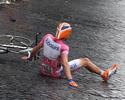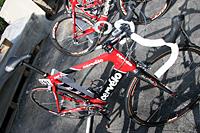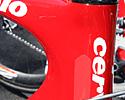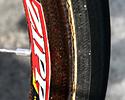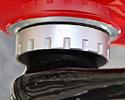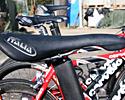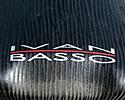
Recently on Cyclingnews.com |
Giro TT tech: Ivan Basso's Team CSC Cervélo Soloist Carbon, May 27, 2006The high mountains are now well and truly on the plotone, and on Stages 19 and 20, the only way is up, up, and away with back-to-back mountain-top finishes. Anthony Tan takes a closer look at one of the maglia rosa's road machines*, the Cervélo Soloist Carbon.Going soloBy Anthony Tan
Like his time trial bike, Ivan Basso's Cervélo Soloist Carbon is an evolution of an earlier aluminium model, the Soloist Team. In fact, the improvements made to Cervélo's P3 Carbon last year, specifically at the downtube and head tube, had a direct impact on the current Soloist Carbon, which explains why the two look very similar. Again, prototypes were tested at 2005 Giro d'Italia, and one of those riders was this year's Amstel Gold champion Fränk Schleck. "I loved the stiffness and responsiveness of the frame, but I asked Cervélo if they could make it more compliant vertically," Schleck said about the first proto he used. "Now that I ride the production version of the Soloist Carbon, I couldn't be happier as I like the changes they have made since the first prototype," he continued. "I feel really comfortable on the bike and on the downhills it is really fast. In the corners, the frame feels very stiff and the handling is direct. This bike is fantastic and very, very fast." Like the P3 Carbon, the Soloist Carbon has a narrow width head tube and top tube, as well a massive airfoil-shaped downtube, retaining that width and volume right until the bottom bracket cluster, the area of highest torsional strain. Internal cable routing and a two-position seat-post is again a common feature to its TT brother, enabling the rider to switch between a standard road and moderately forward (78 degrees) position for time trials. Not that Basso would need it! For all but one stage, Team CSC head mechanic Alejandro Torralbo told Cyclingnews that Basso's road machines will remain unchanged. Of course, that stage the Barcelona football club fan was talking about happened on Wednesday, when the field were supposed to take on the mythical Plan de Corones, which boasted slopes up to 24 percent. However, Mother Nature got in the way, and as a consequence, the climb was cut short by five kilometres less than two hours from the finish. "We use FSA [drivetrains], so we'll still be using those [cranks], but a compact," said Torralbo. "The small [chainring] is 34 [teeth] and 52 [on the front]. In the back, it will be 12-27 for the Plan de Corones - but only [for] Plan de Corones." Asked if there were any exceptions, the Spanish wrencher shook his head: "No, no, everybody is the same. 34 and 27 will be the smallest [gear] for everyone." We caught up with Torralbo on the Giro's second rest day, and while it was a rest day for the riders, he and his sidekick Nick Legan had no such luck. "My rest day is when the Giro is finished!" he exclaimed with a chuckle. "Seven hundred k," Torralbo said about the drive they had to do after the tenth stage that finished in Peschici, before Legan quickly corrected him: "Seven hundred and fifty!" Added Torralbo, "We arrived yesterday in the night, one o'clock. Also, the last transfer from Belgium was one thousand, three hundred k, no stops. We arrived at the hotel seven o'clock [in the morning], had one hour sleep, then got up at 8.30 [to prepare the bikes] for the riders, who started training at 10 o'clock." So, Alejandro, do you like your job? "Mmm... yes," he said with a wry smile, most likely wishing the finish in Milan was tomorrow. * Basso's other road bike he's been using at this year's Giro and for the majority of mountain stages is the new R3 Carbon, no real relation to their R2.5 according to Cervélo's Gerard Vroomen, but primarily designed for the Spring Classics and used by Fabian Cancellara in his winning ride at Paris-Roubaix. PhotographyFor a thumbnail gallery of these images, click here Images by Anthony Tan/Cyclingnews
|
